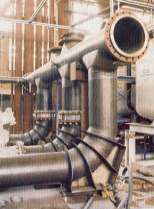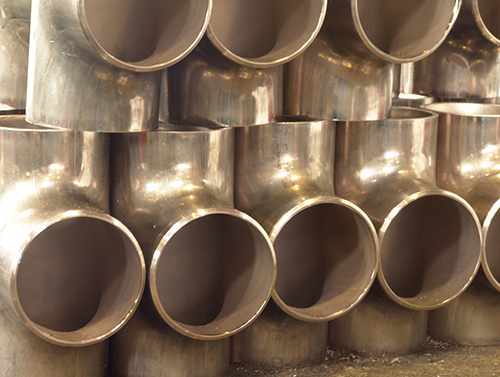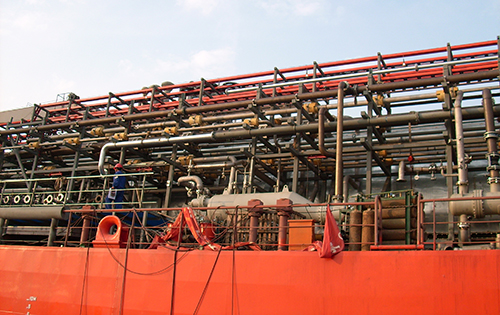 Copper-nickel seawater piping.
Copper-nickel seawater piping.Seawater is used for cooling, oil field water injection and firefighting systems in ship building, offshore oil and gas platforms, power plants and for industrial facilities along the coastline. It is also treated in desalination plants. Managing corrosion with minimal maintenance and a high degree of reliability are major concerns in seawater system design.
The impact of seawater on the performance of a system is determined by its condition, system design, fabrication procedure, temperatures and flow regimes, biological activity and presence of oxidizing compounds. Engineers also consider physical and mechanical properties, availability, material costs, ease of fabrication and maintenance, anticipated design-life and previous design experience.
Many thousands of tons of copper-nickel alloys (UNS C71500 and UNS C70600) have been installed in marine engineering structures for the shipbuilding, offshore oil and gas, power and desalination industries. UNS C71500 (70-30 Cu-Ni) can be preferred for military submarine service due to its higher strength and maximum allowable flow rates, as well as its low magnetic permeability. UNS C70600 (90-10 Cu-Ni) has more widespread use due to its lower cost while maintaining corrosion resistance and biofouling protection.
Elements of Good Seawater System Design
 Copper-nickel T-pieces.
Copper-nickel T-pieces.It is essential to design entire seawater systems as unified, integrated units when selecting materials. The following factors are important to consider in good seawater design:
Heat Exchangers and Condensers: 90-10 and 70-30 Cu-Ni’s are widely used in tubular heat exchangers and condensers for seawater, brackish water and fresh water. Covered in this section are considerations for high performance, including the protective layer, water quality, intake systems, corrosion resistance and galvanic compatibility. System optimization measures, such as mechanical tube cleaning, chemical cleaning, minimum flow rates, standby coolers and condensers and shutdown maintenance are described. A table of typical guidelines for 90-10 and 70-30 Cu-Ni alloy flow velocities for seawater systems is included.
Piping: A wide-range of copper nickel piping systems is used in seawater design. Excellent service is achievable when alloy composition, flow velocity limits, turbulence and water chemistry are considered for particular applications. Guidelines for piping design, installation, connection, surface film formation, erosion corrosion prevention, shutdown and standby conditions and chlorination should be followed. Piping guidelines and references are provided.
Water Hammer: Water hammer is a fluid shock wave caused by a sudden change in flow velocity. 90-10 Cu-Ni works well under conditions that promote water hammer. Information about materials and good practices to manage water hammer and water column separation is provided.
 Copper-nickel piping aboard a ship.
Copper-nickel piping aboard a ship.Galvanic Considerations: To prevent galvanic corrosion in a strong electrolyte such as seawater, the galvanic compatibility of materials must be considered. The Galvanic Series demonstrates that copper-base alloys have similar potentials and can normally be used together without fear of serious galvanic effects (unless area ratios are very unfavorable). Information about galvanic corrosion, The Galvanic Series and best practices in seawater is provided.
Pressure Systems: Copper-nickel is widely used in high pressure systems operating at over 105 bar (~1500 psi) and especially when there is additional need for corrosion resistance or low temperature capability. Copper-nickel is also used in cryogenic pressure systems. The ease of forming copper-nickel alloys into complex fittings and coils ensures their continued use.
Enhanced Heat Transfer: Extended tube surfaces and finned tubes provide 2- to 10-times as much heat transfer area on the outside as the corresponding bare tube.
References
- Copper Alloys in Seawater: Avoidance of Corrosion, Roger Francis, Publication 225, pp 20, , CDA UK, .
- Seawater Pipework References, CDA, .
- Seawater System Components, CDA, .
- Seawater System Design, CDA, .
- The Application of Copper Nickel Alloys in Marine Systems. Material Selection for High Reliability Sea Water Systems, B. Todd, Seminar Technical Report 7044-1919, CDA Inc, The Application of Copper Nickel Alloys in Marine Systems. .
